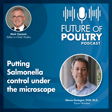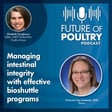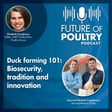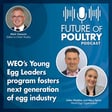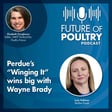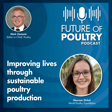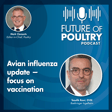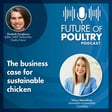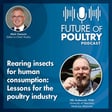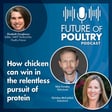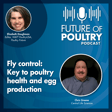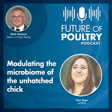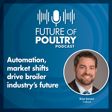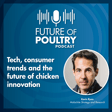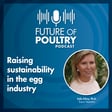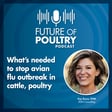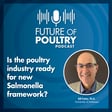Become a Creator today!Start creating today - Share your story with the world!
Start for free
00:00:00
00:00:01

Processing 2035: Doing more with less
Broiler processors have always strived for continuous improvement in the value, convenience and taste they have delivered for consumers. As climate change concerns and overall environmental impacts are prioritized by regulators and consumers, processors will be under increasing pressure to develop circular supply chains and use fewer total resources. Energy conservation, water reuse and packaging recycling will need to be balanced with continuous improvement efforts for food safety, product convenience and cost. Join a discussion with Oliver Hahn, CEO, BAADER Poultry USA; Jay Russell, regional sales director, Marel; and Shawn Harris, executive director of bags and case-ready product marketing, North America, Sealed Air Corporation.
Transcript
Introduction to Poultry Processing Future
00:00:00
Speaker
Hello and welcome to the Future of Poultry podcast series.
00:00:12
Speaker
My name is Terrence O'Keefe. I'm the content director for WAT Global Media. I moderated a panel discussion on the future of poultry processing at the 2024 Chicken Marketing Summit, and I want to share a recording of the discussion with you today.
Panelist Introductions and 2035 Outlook
00:00:30
Speaker
Our panelists are Oliver Hahn, who is CEO of Botter Poultry USA, Sean Harris, who is Executive Director of Bags and Case Ready Product Marketing in North America for Sealed Air Corporation, and Jay Russell, who is Regional Sales Director for Morrell. The focus of the discussion was on the changes we can expect to see in broiler processing over the next 10 years as we move towards 2035.
Sustainability: Air vs. Immersion Chilling
00:01:02
Speaker
When we talk about sustainability and where's the industry going, do we think that immersion chilling of carcasses in water will still be the most common method used in broiler plants in the US 10 years from now? One thing you need to know about me, I love to make machines. That's why I'm still in the industry. It let me outlive my passion. I'm still with the same company I started with. It's barter. I have 30 years experience in the poultry industry. So um chilling.
00:01:32
Speaker
There are, here's what I say as ah as a general sentence, I believe or I know that technology and you know resources,
00:01:44
Speaker
the technology is there and it has largely been there for ah long a long time. So there's advantages in emergent water chilling and there's advantages in air chill. If you just look at the consumption of water, it probably seems to be that the direction most likely will go into air chill. So I believe that air chill will have a stronger full foothold also in in the United States.
00:02:14
Speaker
and elsewhere in the world as it has been implemented in in Europe a long time ago and it just makes sense. So this is my thoughts about that.
00:02:27
Speaker
Yeah, a I'll add to that. I think there's a place for both as Oliver you know articulated out. The biggest thing is wanting to take a consideration of what do you want out of your chilling operation, right? So air chill is going to have benefits of crispier skin. You're going to end up, after you cook it, you know you're not competing with pickup water, so prepared foods can get more efficiency out of the flavor profiles that they do.
00:02:50
Speaker
um You know, you also look at shelf life. So there's some attributes of air chilling that do bring some quality advantages. I think the biggest thing to look at, too, is singulation of product. Right now, you lose that going into immersion chilling. And as you come back out, you try to now redistribute that flock across the back end of the plant. You know, you can build some sales order volume before chilling. So you have, say, three hours to prepare the backside to where you're really able to maximize the quality. So it really just determines, like,
00:03:18
Speaker
What does the plant need to get out of the out of the process? And I think that's where we've gotten lost a little bit on the status quo of you roll a chiller in, you're able to dump all the product in, chill it, redistribute it, rehang it, and then get back into cut up. And I think there's an opportunity there now to own not only on the energy savings and water consumption, but to look at how do you have the transparency and the operation, the end product distribution to where you can have specific routings of that product coming out of air chew without human intervention and touching.
00:03:48
Speaker
which adds some good qualities for the industry. And I think it's just taken a kind of a challenge on that status quo because the US is still the only market that water chills outside of a little bit in Brazil and a little bit in Australia. So there's a question there of why is that? You know, why why have we not shifted on some of those opportunities to to improve the overall quality of the operation? So different You know, they're both advantage yeah advantageous, and it also depends on kind of what do you need after the chiller. You know, what are you wanting to get after that? But again, at the end of the day, it's the responsibility of the plant to produce good quality product.
Water Usage Challenges and Solutions
00:04:23
Speaker
And I think that's where we need to kind of go back and reevaluate this implementation of the technology on what is the best for the consumer, what's the best for the processor, and in the end, what's the best for the environment.
00:04:34
Speaker
Thought that was a great answer. Having to follow that is is going to be extremely difficult. But it was interesting yesterday as our keynote was was talking, and you know you mentioned water was a big thing, and coming from the west, particularly out in southwest Texas, we have more and more people piling in and moving into places where water is going to be one of our largest hurdles to overcome.
00:04:58
Speaker
Maybe not in the next ten years but the next fifteen to twenty years I think sooner or later when you get into places like that he had mentioned desalination well in Texas I know it's close to the Gulf of Mexico but where you get to the rest of it not there not so much in Arizona so moving those moving water to places is going to be difficult but the thing that you hit on that I agree with is there gonna be a place for both and And it's going to be how you market some of that. I know this is not the marketing session, but you know how how does a brand want to communicate with their customer? And that'll be one of the choices that you use on Chilling. And I think here in the United States, it's one thing that we should not ever apologize for. We feed the world, and we do it because we're more efficient. And efficiency, to me, coincides with sustain sustainability. So as we can move
00:05:42
Speaker
more through our plants with less labor, less energy use. You know, it may be that this water chilling, that you know, it's an opportunity for you guys. How do you we recirculate that water? How do we clean that water? Xylums, you know, big into the the water treating industry. So there'll be some large opportunities there. But water chilling is still, that that water medium is the fastest way to for heat transfer. So if you're talking about speed, it's that.
00:06:09
Speaker
That's where we're going to stay. And so if you're looking at a safe, nutritious, high quality product produced at a low cost, water's going to do that. And so you know you're not going to replace it with something else because you have to have contact with the product. You look at other industries, every one of them's braid chill is their brain, that that product down to temperature. So poultry does it a lot more efficiently because they're completely immersed. And I don't think you're going to give up that advantage in terms of cost.
00:06:37
Speaker
No, and I'll add to that. We had a a customer of ours that ended up building an entire plant on air chill because they also run a very high high profitability ingredients business, right? So they had a big marination program, make all their own ingredients, and they wanted to disrupt the market by putting in air chill because you also could produce a product that once it was injected with their own seasonings, there's also an advantage to buying other competitive products where you're still selling more seasonings because you're trying to emulate the taste and duplicate it. So there's opportunities again from like what do you want the end product quality to be and and overall take advantage of that. Just different, you know, and I think there's opportunities for both for sure. Very good. All right. So we talked a little bit about water. What other areas of the processing plant you think have the most opportunity for reducing water usage?
00:07:29
Speaker
I mean, we've got a technology for scalding, you know, so you can, so we have some applications in the in North America and globally on arrow scalding, where we use an atomized ah spray for the scalding function. And so there's opportunities in that aspect. um Obviously, you know, as you look into and air chilling, there's there's opportunities there. And really, when you go to Europe, and Oliver could probably, you know, dive deeper into this for sure,
00:07:58
Speaker
There's zero water usage in the processing plants. They're not allowed to use spray water in the plants, so it's a very dry environment overall. So that being said, the We wash everything. So when you're looking at underneath equipment, we're washing it down a drain. When when we're cleaning off modules, you're washing. When you're trying to move product around, you're rinsing it to try to get it to move on the conveyor belt. So our utilization of water and as a moving medium and as ah as a washing mechanism, then there's some opportunities there to kind of save some money and look at it differently than what it is, which in turn impacts your wastewater cost as well.
00:08:34
Speaker
So from my point of view, if you ask me, whereas is there opportunities to save water within the poach processing plant, absolutely there is. and And yes, if you go to the factories in Europe, they are highly automated and the usage of water is significantly less than here in the United States, there's no doubt.
00:08:54
Speaker
And, you know, yesterday I've learned a lot, and one of the things, you know, you have to say, speak the truth. So if you want, a from my point of view, as a consumer, I don't like water to be used that much. And if you look at it, it depends on the application within the United States, regular poultry plant, you have cut-up operation and further processing, maybe IQF.
00:09:16
Speaker
freezing, you're talking about a million and a half gallons a day. So you compute that
U.S. Shift Towards Air Chilling
00:09:22
Speaker
and that would mean 3,700 households or four people, it's a lot of water.
00:09:28
Speaker
And it is our job. And I'm not opposed to listening, especially to the young generation, Generation Z, and the millennials. And I'm a late, v young baby boomer, I guess, I learned that yesterday. I cook a lot longer for half an hour than half an hour. I guarantee you that. So so to me, water savings is essential.
00:09:48
Speaker
i think Airchill will be taking it will take place here in the United States as well a much larger footprint than it currently is and if there's an opportunity to save water we should do this is not it is not a mill Millennial thing or Gen Z things it's for all of us. It's just it's just better and I think the tipping point from my point of view is definitely once the plant The plants no longer can use well water and and tap into the aquifer and you you know maybe city water. That is also a commercial tipping point where air chill absolutely will outperform. Also on the economical side of things, water chill, no doubt about it. From an energy point of view, they're pretty much the same. But if you have to use city water, you want to do air chill for sure.
CO2 vs. Electrical Stunning Debate
00:10:44
Speaker
Okay, now, when it comes to stunning, I know on the Turkey side, ah for Tom de-boning, controlled atmosphere stunning has some significant paybacks and in de-boning yield. And so the industry here in the US has shifted that way.
00:11:00
Speaker
uh... it's still kind of a niche thing for controlled atmosphere stunning for boilers in the u.s. so uh... and my understanding is that europe went heavily that way but now because of using co two in the stunning that's starting to fall out of favor which way do you think will go in the u.s. for boilers do you think will stay with electrical stunning or you know Go with CO2 stunning or is there something else out there that might take the place of both of them?
00:11:39
Speaker
yeah you don okay so so Let's just say this, right we all know that hanging a live chicken on stand in a shackle you know it it is it is questionable let's just say this right from it from an animal welfare point of view things are a little bit more complicated than that so if you co2 it depends so you have a below ground application for c o two stunning and if you do that then your CO2 consumption over a year is gonna be let me just say it in in in in English less than a car so less than one car if you go below ground but if you go below ground the animal welfare part of things since you cannot really use oxygen into the mix it's you see more adverse behavior
00:12:32
Speaker
below ground But CO2 consumption is extremely low. If you go above ground, you're talking about 400 cars a year. And then you think, OK, so what's 400 cars a year you know in the bigger scheme of things? I think it does make a difference. So if you can reduce it, you should reduce it. Both technologies are available. And you know the way the US s is doing it right now, I mean, there is no really legislation here in the US s that controls this.
00:12:59
Speaker
and Yeah. I mean, if, if, if animal welfare is the driving force, then I, me personally think that CO2 stunning is probably the way to go. Um, simply because you no longer hang a life chicken. And yes, that is kind of questionable to me as well. Adding to that. Okay. Here's here's another spin on electrical stunning.
00:13:23
Speaker
If you look at the challenge of labor after COVID and these plants, you know, we run into a situation of that is the highest turnover area of a processing plant is live hang. So if you do implement something of stuff stunning, some some gas stunning, whether it's CO2, I think we in Europe, they've tested argon, nitrogen. There's a few other methods of extremely expensive, but the the the concern of our force majeure and just CO2's, you know,
00:13:52
Speaker
Branding of co2 right is is always there's looking for alternative methods But that being said you're able to have a lighted environment with very minimal Animal movement, you know, it's a very it's a it's a very well Encouraged the low turnover area once you go to gas stunning. So there's some attributes on that As well as just the product quality. So again going back to the quality discussion How do you pay back air chill? So okay, or how do you pay back gas stunning? So it's mainly on blood spots and trim loss that you've seen in the, and even on the Turkey industry is when you hang a bird in a shackle and you're, you've got wing breakage as you don't, you have. issues when you hang them in the shackle. They're trying to pull themselves up in the shackle. So you have some dark meat, blood spots. you then you Then when you hit it with electricality stun, you're going to sit there and have potential for blowing out of keel on the smaller products. So with that, you have
00:14:51
Speaker
opportunities to yield higher in your plant if you take the necessary protocols of managing your gas consumption and the gas gradients during the stunning process because faster is not better than gas stunning. So what you do know is your plant is going to run slower if it goes to gas stunning because you cannot process as fast.
00:15:10
Speaker
as as electrically stunned, but the end result is higher quality, less labor, less trim, less turnover, all of those attributes that add up into a different ah ROI when you look at the overall um payback model. Jay, I'm going to start answering before you because that was extremely articulate and and I will just say that economics are going to decide where it goes and again it's going to be ah Speaking from brand owners out of it again, what do you want to communicate with your consumer? You know, you listened to everything from yesterday and and how particularly Gen Z were looking at those being the next ones with purchasing power. They want the transparency. They want the communication. So if they feel like you do Oliver, that that's cruel hanging a live bird, they may turn to another place. And so even with all the economic benefits you're talking about, perception.
00:15:59
Speaker
You're going to lose that perception. You'll end up losing losing the battle. And labor being such an important factor right now, particularly in these high turnover positions. But with CO2, it does have the the bad branding. So when you're talking about greenhouse gas, et cetera, that doesn't necessarily mean that you can't look at other things, you know, with nitrous. You had mentioned argon. But there's going to be have to be something else out there that would be lower cost that would not cause the the dysphoria, et cetera,
00:16:26
Speaker
that you can move things through faster. And that's what we have universities for, to to to be on the the leading and cutting edge of that. So I would tell you, we're probably not even doing what we're going to be doing 10 years from now. Yeah, and it's hard to make it attractive, too. We try to make this cartoon of gas stunning like, oh, look, and it's it's very difficult to make any slaughtering attractive, even though it's a necessary process process part of the process to get the end result.
00:16:52
Speaker
Maybe one more thing I can
Technological Advancements in Processing
00:16:54
Speaker
say. So to me, technology and resource utilization will always be advancing and it has the implementation or the pace of the implementation of this technology.
00:17:07
Speaker
That is not up to an equipment manufacturer or just the portrait processor or just the consumer. It is up to all of us to make that happen. And the one thing that i that I believe is that the pace of these implementations will be significantly faster going forward than looking backwards. I'm quite sure about that.
00:17:28
Speaker
I know one of the challenges for existing facilities is that both gas stunning and air chilling take more square footage. And and so that becomes sometimes the the primary reason someone can't make the switch because it means building a bigger building and shifting lines and all that. When it goes back to even in that, are we are the plants that have a majority of 1960, 70 assets, are they configured the right way?
00:17:57
Speaker
you now need a rectangle, because the technology needs a rectangle. Your building's a square. you know so how do we now and then And then guess what? The city's not going to give you any more land. So how do you how do you navigate some of those as we move forward? So again, I think that what we're going to see in the next 10 years is a shift completely and in assets and how they're designed, what what they look like, and what's needed for the future. Because what we've been struggling with from an equipment standpoint is we're trying to shove all of this automation into a space of this of this you know say this square footage and you need four times this amount of square footage and then then you worry about you know the the welfare of employees and you know egress and OSHA and all the other fun things that come with it so you want it all but we've got to make some sacrifices too is the challenge and somebody has to pay for it.
00:18:44
Speaker
Okay, Sean, I've got one for you in your wheelhouse. So packaging options for retail chicken products have improved over the years to minimize or eliminate leaks, improve shelf life. Recently, I've been starting to see some materials come across our desk where they say the packaging's compostable.
Innovations in Packaging for Sustainability
00:19:07
Speaker
or recyclable, and how do you think packaging is going to change over the next decade? ah One of the things that that we we do at the CryVac brand, we do a national meat case study on the fresh side about every three years, and so we've been doing it since 2002.
00:19:24
Speaker
And we'll we'll do it again in 2025 in the first quarter. And so what you can we can break it out by the total fresh case or by individual species. And so we can track how how that's gone over the past 20 years. So you look at that extrap extrapolating forward. One of the big things is the way people get their food. yeah And you look at how you how you how you can acquire your food. And there's three channels now. It's food service, it's retail, and it's home delivery.
00:19:56
Speaker
And that's that's the way we get it. So with COVID, that home delivery really jumped. And so one of the things that went along that was more leak proof packaging. And we've talked a lot about water chilling and things like that that actually, you know, make more purge in the product. And so that leak proof packaging and poultry is paramount because no one wants something delivered to their home with their fresh vegetables.
00:20:20
Speaker
with chicken juice on it. So one of the big things we've seen over the last few years is the influx of more roll stock packaging or vacuum packaging and you know vacuum in the early 2000s was about five or ten percent of the case. It is now the predominant package in the case.
00:20:39
Speaker
On all species, on poultry, it still trails behind tray pack considerably, but it's made up ground considerably. and so If you keep going on that pace in 10 years, I do think you'll see the vacuum package product outpaced the tray pack.
00:20:54
Speaker
And you ask, and you go back to you guys area, why is that tray pack win? Over and over and over. One, our customers, our processing customers are capitalized that way. It takes, you know, you're talking about 30 to 50 million to recapitalize the plant to change packaging. If you're selling it now, why why would you really need to look at doing it unless the consumer demanded it? And on top of that, it's the throughput. Particularly people are used to having styled product and with the tray, you can offline load.
00:21:25
Speaker
and take that product to ah to an OSID machine, which is the machine that's used out there, and now your throughput is so much faster and you can produce multiple products at the same time without sacrificing your throughput. When you go on to any type of vacuum package, styling product,
00:21:41
Speaker
the way consumers are used to seeing it changes. The eating quality changes because when you're in that vacuum package product, particularly things that are water chilled, you have it sitting in its juice for up to 21 days. So it has a different flavor profile. We're actually having North Carolina State take a look at that for us, what what what the difference is there. So is is there real differences in eating quality besides just perception?
00:22:08
Speaker
ah But the the biggest thing that's happened in the last couple years that'll change going forward is the banning of expanded polystyrene foam on the coast. And so actually people have come through and the solutions that are out there, and we're part of that as well, is to replace that with some type of polyester tray or solid PET tray. And it's actually a less sustainable solution because you're using more material It's a harder product to package, and so you're creating more leakers or more leaking packages. And so at the end of the day, you're you're going, wow, we're doing this because a municipality has banned something that's working. And so ah one of the things that we're doing, we have come out with a compostable product, particularly as ah an expanded polystyrene foam replacement. But I will tell you, that's gonna over the next 10 years, that will penetrate the coast heavenly heavily.
00:23:04
Speaker
Middle America, what we would tend to call flyover country, it's not going to change. It will not change because the cost is 3x. And so are you really getting a benefit? Yes, it uses recycled content resin. And yes, it completely disappears in three to six months. And so the end of life story is great. But you're still putting or linear low density polyethylene around that to to get it to be leak proof.
00:23:32
Speaker
and One of the things we've done with packaging over the years, we've ended up tremendously. So the amount of product you're using is less than we're using in in the early 2000s and in even even less before that.
00:23:45
Speaker
So it's it's the total pounds of packaging per pounds of product is half of what it was 20 years ago. It'll probably be half of that again in 10 years. And that's where we'll make inroads on the sustainability. You had mentioned recyclability. You have a lot of pledges out there now to to use recycled content or have everything completely recyclable. Problem is you can have something designed to be recycled ready, but once it has food contact on it, it's no longer recyclable.
00:24:14
Speaker
it doesn't There is not a stream in this country that can take product that has food contact on it. so you know I would suggest going to a material recycling facility in your community. They'll they'll gladly give you a tour. The only thing that they're really recycling out of there is water bottles, corrugated,
00:24:37
Speaker
Aluminum and newsprint, which we don't even have that anymore. I mean, you can have a clamshell of a strawberry package that's 100% PET, same as a water bottle. That'll go to landfill because they don't have the sorting capability. So it's eye-opening. We're doing all these things to feel good, but we're actually not making a difference with it. And so before we can move to that heavily in the next 10 years, there'll have to be investment in infrastructure to actually collect the material.
Automation and Uniformity Benefits
00:25:07
Speaker
Clean the material, densify it, and get it back to a place where you can reuse it. And to be sustainable all along that chain, it has to be profitable, or it'll have to be subsidized by the government. I don't think we're willing to do that at this point in time.
00:25:23
Speaker
The recyclable packaging, I always find interesting just from the standpoint of I'm old enough that when I was a kid, we actually had milk delivered to the house in the glass bottles that got returned. We used to make our you know money for a candy bar by going around and picking up soda pop bottles and bringing them back to the store.
00:25:44
Speaker
and So what killed all that? Is it just so much cheaper to make a glass bottle than it is to bring it back and wash it? I bring bring you back to the MRF again. You go into a material recycling facility and you put your glass bottle into your your bin. That all goes to landfill because it's cheaper to make new glass than it is to recycle used glass. And again, if there's not money into it, people aren't going to do it.
00:26:12
Speaker
so it sounds like what you're saying is the marketing I'll way ahead. I think you're going to have, again, the places on the coast are going to stick with it. So if you're marketing heavily into there, selling heavily into there, they're going to do their darnedest. But even the largest in Bentonville, they've got what they would call a PDC, which change is commonly known as Saran. It's a barrier in shrink bag packaging. But they will not enforce that if it adversely affects shelf life. But even on the coast, the parking
00:26:57
Speaker
chain has gotten negative versus rock right so most of your you know i didn't know there' I saw one retailer here, Aldi, and didn't get to to ask a lot of the questions. But a lot of the retailers are taking a wait and see on their 2025 pledges right now, seeing where the market shakes out. So we're still trying to stay up with it. It's changing that fast. Systems have been developed now for automatically sexing chicks in the hatchery.
00:27:27
Speaker
And that allows for sex separate in case for Wayne Sanderson. Now they have two complexes that yeah one's males, one's females, completely different product lines and all that. How big of an opportunity from a processing standpoint do you think that is? I mean, you're going to have greater uniformity because you aren't going to have males and females. But I guess if you have two like if you had two cutout lines now, you can separate them.
00:27:54
Speaker
you know Is there going to be some significant payback? So yes, the answer is simply yes. right So as an equipment manufacturer, we love that. and And I do think that what Target has done is very disruptive. I admire that. It's a technology that is now available. And you know there's no doubt that if you have a more controlled flux size,
00:28:22
Speaker
Your yield numbers will go up, your maintenance will go down, things like that. It just it just simply makes sense from from all aspects. So, yeah, for us it's it's great. It's great in cut-up. It's going to be phenomenal on automatically boning. We're still trying and working hard. We have really made great progress. But if you have a more controlled flux size, you're automatically boner.
00:28:45
Speaker
We'll probably get very close to your skilled handy-boarding line and you no longer have experience, yield disadvantages if you go to automation. So controlled size of the birds in the factory is definitely beneficial.
00:29:01
Speaker
Yeah, 100%. So it's on length, you know, size, you know, that I think once you're able to sex birds, and we've seen it because in these plants that that are running sex bird programs, you're the uniformity is there, the production is consistent, you know, every, every, the the machines don't self adjust per bird, we can get them to self adjust per flock.
00:29:20
Speaker
But you can't do it in the production volume that they're running at the rate that that is going. So there is some tolerance. Obviously, there's thresholds depending on what machine it is on tops and bottoms of what that weight limit can be across. And it's not like the machine explodes if it's over the weight limit or under. You just get rework. You get issues coming off of it. So again, it's how do you dial in a process and you're able to utilize that process in its highest efficiency rate And with that is managing inbound product. You manage inbound product, that that that plant will run like a dream. With the variability of product, poor grow out issues with, but wait, you the plant can't fix that. You're bringing in all that. You need to sort it, size it, arrange it going into the to the line, or you're going to have to deal with an army of rework or or potential product loss across the units just because of the the lack of of effort put into to ensuring that the quality coming into the plant.
00:30:15
Speaker
as well. It's like they'll, you know, crap in, crap out tight type discussion. So, but yeah, obviously the automation works like a dream once you're able to size correctly and you you know, you could do certain things in the backside of the plant to overcome non-sex But really running a pure program to where you're able to earmark what your yields are going to be. If you know your inbound weights and it's all males or all females, you're you're able to do it. and And turkey industry does a good job with this. It's just something that's now coming more to the poultry side of things of on how do they how do they look differently at this opportunity. Remember, if you've got questions, give us, raise your hand.
00:30:53
Speaker
I agree with everything you guys say, and I'm just sitting there thinking, okay, let's take it one step further after you guys get through with it, and then it gets to the end user. ah The consistency that you have all the way, and that's one thing that poultry has an advantage over the other proteins in in the space, is that it's a consistent product every time. But imagine if you went to market on the end use, particularly as people are are getting getting their products in different ways, that you go to a net weight with a single price package.
00:31:22
Speaker
for tenders or different things like that that were fresh. And so is is it on the marketing side of it, if if you're controlling and Poultry being vertically integrated from the hatchery through the through the final package, if you could have it so tight that you get all the yield advantages, throughput advantages you're talking about, now you put it in a net weight package that it's just one price out the door and consistent, consistent, consistent, that would be a game changer.
00:31:51
Speaker
All right, so if you look in your crystal ball 10 years out, is second processing going to be as automated as first processing is today? Yeah, yeah I mean, ah the technology is there. I think the the the application, and it It has to do with allowable square footage in some of these plants. that but in order i mean Robots have been packing poultry and in and everything on the on the packaging side of automatically getting into thermal form packages. All of that's there. It exists in some form of function and in majority of the plants here. But to have a full processing line that's fully automated, it's doable. It has been. you know the The pathway that the US has taken has been different. It's like I'm going to automate debone.
00:32:39
Speaker
Okay, well that's, do you know you know, realistically you could automate it after debone and keep your hand portion lines and maximize yield and manage it that way differently than I'm going to now put a machine in and expect it to do but be a silver bullet. Because there's not a silver bullet, there's all everything touches each process to to contribute to what happens next. So I think with that being said is,
00:33:02
Speaker
There's there there are gaps in skill sets of plants. There's opportunities to partner with trade schools to be bring a higher level of education around PLC technology around just robotics in general. It's not hiring the the kid who you know or the individual.
Future Plant Designs and Technology
00:33:19
Speaker
who has an aptitude for mechanical. it's a it's It's now evolving into, what are we going to do with AI? you know If you look at trim functions and you look at the efficiency of people putting putting pieces here, well, why is that person putting a piece here when they should be doing this? So again, some of that technology also exists. And we're also rolling out to where we're implementing it, to where you look at the overall efficiency of the backside. That's where all the people are. you know so that's and And there's tremendous opportunity in capitalizing on that.
00:33:49
Speaker
Challenge of it is is cost. you know it's It's square footage, it's cost, and then it's the skill set gap at the plant level and in order to put in some of this automation and really run with it. So just to add to it, I said it before, technology is largely available. They're doing it in Europe and elsewhere in the world, highly automated factories. It is definitely possible. And i again, you know it may be it has been at a slower pace in the past. It will be a much, much faster pace in the future.
00:34:18
Speaker
And sheer labor availability will force that issue. It's just as simple as that. And, you know, so if you ask me what it's going to look like in 2035, a lot more automation, and definitely in the back end of the plan, there is a lot of labor there for sure. Evisceration in first processing, if you go through a plan that is already largely automated, even though there's opportunities,
00:34:40
Speaker
But the the the majority of the opportunity is in further processing, automatically burning, cut up, and so on and so on. So definitely, we're going to see that. I think what you were talking about with the size of the birds being more consistent is going to enable those things. And it's going to get to be a point where it's not just going to be a cost advantage for you. It's going to be table spudates to do business. you're You're not going to be able to to not do it. And some of the biggest hurdles, like you say, are the the age of our plants, the size of our plants. I think that you'll start you know having reinvestment. It may be that there's more regionalized specifically designed to do this.
00:35:18
Speaker
And then you can take what you have now and make it distribution centers or do something else, not just completely do away with the real estate. But everything that we've kind of talked about this morning is going to come into that. So it's going to be the water use, et cetera. So I think the questions you're building to, what's the plants the plant of the future look like? And i I don't know if that's on the sheet. I know we reviewed it a little bit, but you may have pulled the FAFSA on us and and put that down at the bottom. But I think that's kind of what we're building up to here today.
00:35:46
Speaker
The thing to add to that, the the production process, as is designed today in the majority of the plants, is what I call management by piles, is you'll singulate, create a pile, redistribute, create another pile. Then I create a combo. Then I'm moving this combo over here, and I'm dumping this combo up. And then I'm bringing this combo in, and I'll reprocess it. It's just management by. And so the thing is first in, first out, and getting it into a one-piece flow is where the opportunity is at, to where whatever mechanism is used upfront, to where as soon as that product comes off the bone and then you're able to now run it through a processing line to where you singulate and keep the and keep the the uniformity of belt separation and then have an opportunity also to go back, heaven forbid there's a product recall, but you have traceability of that product going through each stage so that when you're looking at case counts, you're not all of a sudden putting seven million pounds on hold. You end up extrapolating that down and and deducing it down to 250,000 because now you know exactly
00:36:44
Speaker
where that product was at what. And that technology exists. It's just we have to adapt a method to where once you're running it through the process, you're not all of a sudden reintroducing a pile of product that came from a tote or dumping a combo up without tagging it, scanning that tag, knowing where it came from, then redistribute it. But right now it's a little more chaotic than that, you know, in the backside of the plant for lack of better terms.
00:37:06
Speaker
I would like to thank our panelists for joining us for this discussion. I hope you enjoyed it. We invite you to join us at the 2025 Chicken Marketing Summit, which will be held July 28th through the 30th at the DeSoto Hotel in Savannah, Georgia. We will launch registration for the 2025 Chicken Marketing Summit in March of 2025.
00:37:32
Speaker
Thanks for joining us for this episode of the Future of Poultry podcast series and be sure to subscribe.

